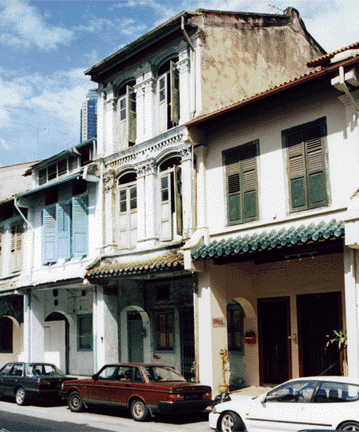

View of Chinatown's restored shophouses on Amoy Street.
[Photographs © George P. Landow and may be used without written permission for any educational purpose. Any commercial or other use requires prior written permisison from  .]
.]
These buildings, like the structure on the corner of Amoy and McCallum Streets, seem to exemplify good architectural restoration and the issues that even it raises. These shophouses, or former shophouses, look physically sound, lived in, and generally appear to capture (!) much of the flavor of the original buildings in their original suroundings, though an enormous skyscraper does make its way into the picture. These buildings, unlike some other quite charming ones in Singapore, do not, in other words, appear so perfect, so bright and shiny, that they appear to belong in Disneyland or to the world of The Truman Show.
These buildings succeed because they bear marks of being situated in a time-marked environment. In particular, the weathered shutters and no-longer-pristine sidewall of the tallest shophouse conveys some of its passage through time, thereby embodying what the great architectural and social critic John Ruskin called age-mark. Nonetheless, these buildings have passed through time, and they have arrived at an era in which the technologies of sanitation and transportation have changed so fundamentally that one wonders to what degree can one restore such structures -- if by "restore," that is, one means in some way to render them similar to their orginal modes of existence. The problem here of course arises in the fact that every structure took form within a particular, distinct environment, and it is not at all clear that one can restore one building, which originally a particular role in an architectural ecology, without restoring the whole, even if such were possible or socially and politically responsible. What, then, are the effects of modern automobiles lining both sides of Amoy Street, and what about the absence of people filling the streets? To what extent can one have a shophouse that now provides home for a brokerage house, solicitor, or advertising firm? On the other hand does one wish to bring back, not only the bustle, but the filth, animal dung, and odors of the city 150 years ago?
Can you think of any ways that the literature and other arts of Singapore tackle these issues of modernization and preservation?